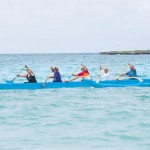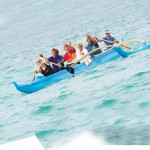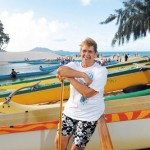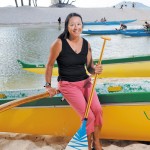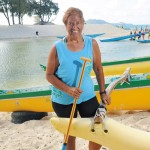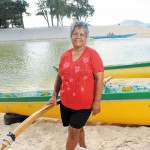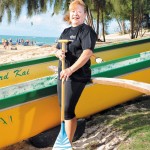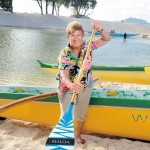Women Of The Channel
It’s too long and too rough, the guys practically laughed, when a group of women said they wanted to paddle the Kaiwi Channel from Molokai. But they kept training, and in 1979 Na Wahine O Ke Kai was born. As the 35th race nears, we salute the pioneering women of the channel
American opera singer Beverly Sills once said, “You might be disappointed if you fail, but you are doomed if you don’t try.”
For more than 20 years, women paddlers not only were told they could not successfully cross the Kaiwi Channel, they were even told, “It’s too dangerous to try.”
- Hannie Anderson (white shirt) with (from left) Carleen Ornellas, Shelly Gilman, Carol Young, Haunani Olds and Rose Lum in Kailua
- Training off Kailua beach with Flat Island in the background | Nathalie Walker photo
- It’s too long and too rough, the guys practically laughed when a group of women said they wanted to paddle the Kaiwi Channel from Molokai. But they kept training and agitating, and in 1979 Na Wahine O Ke Kai was born. As the 35th race nears, we raise our paddles to the pioneering women of the channel. Paddling here (from left): Haunani Olds, Shelly Gilman, Hannie Anderson, Rose Lum, Carol Young and Carleen Ornellas | Nathalie Walker photo
- Hannie Anderson
- Carleen Ornellas
- Shelly Gilman
- Carol Young
- Haunani Olds
- Rose Lum
Sitting idle was never an option
The dream for a women’s race started two years after the first men’s Molokai to Oahu race in 1954. A veteran women’s crew from Waikiki Surf Club asked coaches and race officials to consider a similar event for women. Critics insisted women couldn’t handle the treacherous and unpredictable Kaiwi Channel.
They were wrong. “When the subject of doing Molokai came up, the men told us it couldn’t be done,” says veteran paddler Carleen Ornellas. “We knew we could do this!”
It would take 21 years before someone would listen
Ornellas and Donna Coelho-Woffe were pioneers who believed. Both women paddled for Kailua Canoe Club and approached Leinani Faria with the grand idea. The women wanted to race from Molokai to Oahu and prove that the channel was not reserved for men.
“She listened and was committed to help us because she believed, too,” says Ornellas.
But despite their drive and will to succeed, the women knew they would need the support of men.
Support, not approval
“We knew we needed to find guys who were willing to take us across the channel,” says veteran paddler Rosie Lum. “Someone who was willing to take a chance and somebody who believed we were ready.”
Two crews believed they were ready. One group, spearheaded by Coelho-Woffe, was made up of women from Kailua, Outrigger and Lanikai canoe clubs and Waikiki Surf Club. They named themselves “Onipaa.” The other crew was from Healani Canoe Club, coached by Babe Bell.
It took years of patience and persistence to convince everyone that it was possible for women to paddle across the Kaiwi Channel. In October 1975, 36 women made the first unofficial crossing.
“We trained like crazy and it was awesome,” says Lum. “Healani beat our tails that day, but when we got to the finish line at the Ilikai Hotel, we knew we had accomplished something very special.”
The women proved to the world – and to the men – that they could paddle 41 miles.
Faria and Hannie Anderson officiated the first crossing.
“The girls in ’75 proved that it was possible,” says Anderson. “We set a goal and achieved it. It is still one of the most gratifying days of my life.”
Faria tragically passed away from cancer, but before she died, Ornellas says she told the women, “Keep going, keep doing this, you women can do this.”
Hannie Anderson took the reins that day and never stopped believing
Four years later, the women would organize to do it again, but this time as a sanctioned event. In February 1979, race director Anderson founded Na Wahine o Ke Kai Association with support from committee members Shelly Gilman, Haunani Campos-Olds, Sig Tannehill, Carol Young, Ornellas and Lum. Puna Dawson christened the event Na Wahine o Ke Kai, or “Women of the Sea.”
“Hannie was focused on making this happen,” says Lum. “She was the mover and shaker in fulfilling our dreams.”
It was a dream shared by many women, and Oct. 15, 1979, it became a reality. Sixteen crews left Hale o Lono bound for Oahu. Outrigger Canoe Club finished in six hours, 35 minutes, 14 seconds in its first official women’s Molokai-to-Oahu canoe race.
“In 1979 there were still doubters, but we jumped for joy that we had 16 crews,” says Anderson, who has never raced across the channel. “In order for me to compete in the race, I would have had to train. Instead, I took the bull by the horns and served as race director. Organizing the first official race was a rewarding feeling. I have no regrets.”
But after making history in 1979, the race was cancelled the following year because of 30-foot surf and strong winds. Anderson remembers the weekend well.
“The day before the race, the Coast Guard advised us to cancel,” she recalls. “The next morning they called and asked, ‘Have you decided what you’re going to do because it’s blowing hard in the channel.'”
Anderson drove down to Hale o Lono Harbor and made the decision not to let the wahine go.
“I stood in front of 18 crews and told them the race was cancelled,” says Anderson. “A few of them thought they could make it and they weren’t happy. In fact, some of them were very upset. And there were others who were happy because they were scared.”
“Several crews wanted to go, but I was very happy not to go,” recalls Ornellas. “I know my limitations and I respect that ocean.”
Race officials helped organize return flights back to Oahu for the paddlers. On Anderson’s flight back, Hawaiian Airlines pilot John Carroll flew officials over the channel and pointed to the mammoth ocean swells.
“John wanted to show us how big the waves were, and then he said, Hannie, you made the right call, ” says Anderson. “The waves were 30-35 feet. We were very fortunate.”
Although 1980 was the only time the race has been cancelled, in 2012 Anderson and her race committee were faced with a similar decision. But this time waves in the channel weren’t the issue – the problem was at Hale o Lono Harbor.
A potent northwest swell was generating massive waves that were closing out the harbor s entrance. Race officials warned crews to time the sets as they exited the harbor. Ten canoes were overpowered by waves estimated between 10 and 12 feet as they raced to the starting line. One canoe was damaged and was towed back to shore. A 30-year-old paddler was transported to Molokai General Hospital with injuries to her ribs and shoulder.
“We didn’t cancel the race because the women wanted to go,” says Anderson. “It was a tough call to make, but once again we made the right decision. I’ll be honest, I did say several Hail Marys.”
Since 1979, Outrigger Canoe Club has won the race four times: 1981, 1984, 1985 and again in 1992. Hui Nalu Canoe Club won the event in 1982 and 1983.
Go JoJo
OffShore Canoe Club of California dominated the race for several years, paddling to consecutive victories from 1986 to 1991 and again from 1993 to ’96, setting a new course record of five hours, 24 minutes, 32 seconds in 1995. JoJo Toeppner was on those winning crews. In fact, Toeppner has raced in all 34 races and expects to be back for her 35th race in September.
“The chance to paddle across the channel, getting anything from glass to 20-foot waves, is one of the most exciting experiences. It teaches me to respect the ocean and learn how to work with the waves, currents and my team to make our way across,” says Toeppner. “All the challenges that come up during the crossing teaches me to accept what is thrown at me and enjoy it.”
“She is the only woman who has been in every race and she’s stroked several winning crews,” says Anderson. “JoJo represents the spirit of this race.”
“JoJo keeps coming back and, trust me, it takes more out of you when you get older,” adds Ornellas.
Ornellas is the only race committee member who still competes in the race. She also continues to be one of the top steerswomen in the state.
“I ve done at least 30 Na Wahine and counting, but I can see the end of the tunnel,” laughs Ornellas, who has paddled for Kailua Canoe Club for 42 years. “You want to be competitive and you never know what kind of channel you’re going to have out there. The better you train, the less painful it is.”
No longer a proving ground
The channel is no longer a proving ground for the women. Many who compete are world-class athletes; some are even former Olympians who aim to shatter records.
“It’s a different athlete out there,” says Anderson. “The women today train rigorously year-round, cross-train and eat well. Some of them come to Hawaii with dreams to win!”
“The finishing times are way faster than they were 35 years ago,” says Ornellas. “We’ve learned so much in this high-tech world. We originally came across the channel with Cokes and candy bars, and now we’re drinking proteins and power drinks.”
The canoe race has flourished through the years, attracting crews from all over the world because of the tireless efforts of race volunteers and supporters. Anderson is grateful for sponsors but understands that times and budgets change.
“It is our state sport, but businesses don’t financially support the race like they did in the past,” says Anderson. “That’s why we send out letters and ask businesses and community members for help. There have been years when we used our own money to make sure the women have this opportunity. That’s how much we believe in this race; that’s how much love we have for this sport.”
Others have stepped forward to help cuts costs. Anderson says each year about 20 emergency medical technicians donate their time and come across the channel on escort boats. It is a huge cost savings without compromising safety.
“If there’s an emergency out there, we can have one of them at the canoe within minutes,” says Anderson.
“The EMTs don’t charge us for their services and we appreciate that very much.”
A new partnership
For the first time in history, race committees from Na Wahine o Ke Kai and Molokai Hoe are joining forces on all aspects of race planning, including logistics and sponsorships. The Na Wahine O Ke Kai committee will team up with organizers from Oahu Hawaiian Canoe Racing Association (OHCRA), who put on the men’s Molokai Hoe. It is the hope that this new direction will align resources and bring more support to both races.
“We are happy to team up with the Molokai Hoe officially,” says Anderson. “We felt it was important that we pull all our resources together so that we can leverage our strengths to put on the premier races for the sport of outrigger canoe racing in the world.”
Organizers anticipate more than 200 crews and 2,000 paddlers will compete in this year’s races, including clubs from Australia, Canada, New Zealand, Japan, Guam, Tahiti and the continental United States.
“This coming together will allow us to streamline a lot of the logistics that go into planning such a large event,” says Molokai Hoe race director Stan Kaleianaole Dickson.
Dare to dream big, refuse to be denied
On Sept. 22, more than 80 women crews from all over the world are expected to take on the Kaiwi Channel for the 35th time, thanks to a group of women who dared to dream big and refused to be denied.
“What a great milestone, and it’s exciting to see how far this race has come,” says Ornellas. “This is the world championship of long-distance outrigger canoe racing. If you’re a paddler, then your goal is to do Molokai. It feels good knowing that we helped pave the way for other women.”
Anderson gets emotional when she reflects back on 35 years. She’s reminded each year of why she’s remained focused on fulfilling the dream when she stands before the women for the traditional pule and chant.
“Tears pour down my face when I see the women hold hands, hug and kiss on race morning,” says Anderson. “I never thought I d live to see the day that we’d be here 35 years later. It’s the most gratifying feeling to see this dream come true. I believed the women could do it more than 30 years ago, and I get chicken skin knowing they believe in themselves.”
All they ever needed was a chance to try.
For information, registration and pre-race activities, visit nawahineokekai.com.


